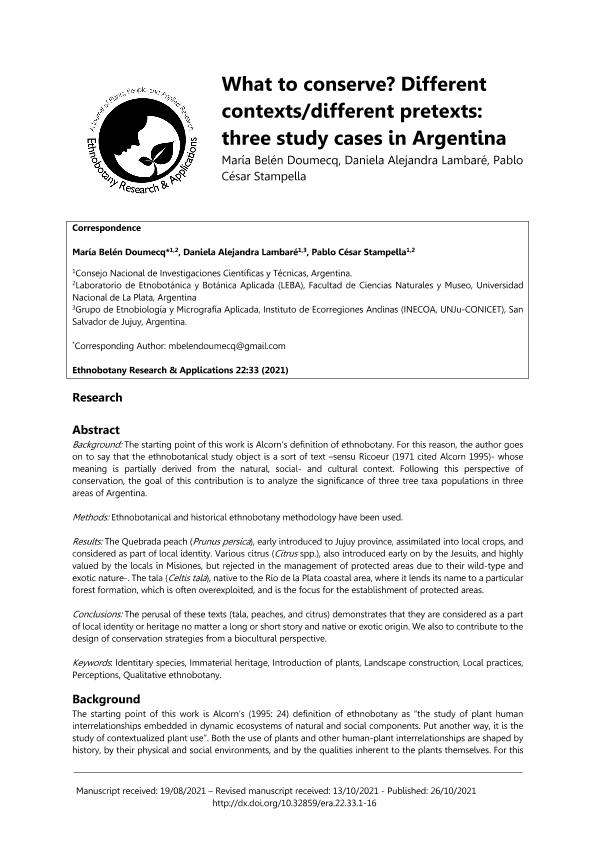Mostrar el registro sencillo del ítem
dc.contributor.author
Doumecq, María Belén

dc.contributor.author
Lambaré, Daniela Alejandra

dc.contributor.author
Stampella, Pablo César

dc.date.available
2022-08-10T15:00:51Z
dc.date.issued
2021-10
dc.identifier.citation
Doumecq, María Belén; Lambaré, Daniela Alejandra; Stampella, Pablo César; What to conserve? Different contexts/different pretexts: Three study cases in Argentina; Ilia State University; Ethnobotany Research and Applications; 22; 10-2021; 1-16
dc.identifier.issn
1547-3465
dc.identifier.uri
http://hdl.handle.net/11336/164969
dc.description.abstract
Background: The starting point of this work is Alcorn’s definition of ethnobotany. For this reason, the author goes on to say that the ethnobotanical study object is a sort of text –sensu Ricoeur (1971 cited Alcorn 1995)-whose meaning is partially derived from the natural, social-and cultural context. Following this perspective of conservation, the goal of this contribution is to analyze the significance of three tree taxa populations in three areas of Argentina. Methods: Ethnobotanical and historical ethnobotany methodology have been used. Results: The Quebrada peach (Prunus persica), early introduced to Jujuy province, assimilated into local crops, and considered as part of local identity. Various citrus (Citrus spp.), also introduced early on by the Jesuits, and highly valued by the locals in Misiones, but rejected in the management of protected areas due to their wild-type and exotic nature-. The tala (Celtis tala), native to the Río de la Plata coastal area, where it lends its name to a particular forest formation, which is often overexploited, and is the focus for the establishment of protected areas. Conclusions: The perusal of these texts (tala, peaches, and citrus) demonstrates that they are considered as a part of local identity or heritage no matter a long or short story and native or exotic origin. We also to contribute to the design of conservation strategies from a biocultural perspective.
dc.format
application/pdf
dc.language.iso
eng
dc.publisher
Ilia State University
dc.rights
info:eu-repo/semantics/openAccess
dc.rights.uri
https://creativecommons.org/licenses/by-nc-sa/2.5/ar/
dc.subject
IDENTITARY SPECIES
dc.subject
IMMATERIAL HERITAGE
dc.subject
INTRODUCTION OF PLANTS
dc.subject
LANDSCAPE CONSTRUCTION
dc.subject
LOCAL PRACTICES
dc.subject
PERCEPTIONS
dc.subject
QUALITATIVE ETHNOBOTANY
dc.subject.classification
Otras Ciencias Biológicas

dc.subject.classification
Ciencias Biológicas

dc.subject.classification
CIENCIAS NATURALES Y EXACTAS

dc.title
What to conserve? Different contexts/different pretexts: Three study cases in Argentina
dc.type
info:eu-repo/semantics/article
dc.type
info:ar-repo/semantics/artículo
dc.type
info:eu-repo/semantics/publishedVersion
dc.date.updated
2022-08-03T18:10:59Z
dc.journal.volume
22
dc.journal.pagination
1-16
dc.journal.pais
Georgia

dc.journal.ciudad
Tbilisi
dc.description.fil
Fil: Doumecq, María Belén. Universidad Nacional de La Plata. Facultad de Ciencias Naturales y Museo. Laboratorio de Etnobotánica y Botánica Aplicada; Argentina. Consejo Nacional de Investigaciones Científicas y Técnicas. Centro Científico Tecnológico Conicet - La Plata; Argentina
dc.description.fil
Fil: Lambaré, Daniela Alejandra. Universidad Nacional de Jujuy. Instituto de Ecorregiones Andinas. Consejo Nacional de Investigaciones Científicas y Técnicas. Centro Científico Tecnológico Conicet - Salta. Instituto de Ecorregiones Andinas; Argentina
dc.description.fil
Fil: Stampella, Pablo César. Consejo Nacional de Investigaciones Científicas y Técnicas. Centro Científico Tecnológico Conicet - La Plata; Argentina. Universidad Nacional de La Plata. Facultad de Ciencias Naturales y Museo. Laboratorio de Etnobotánica y Botánica Aplicada; Argentina
dc.journal.title
Ethnobotany Research and Applications
dc.relation.alternativeid
info:eu-repo/semantics/altIdentifier/url/https://ethnobotanyjournal.org/era/index.php/era/issue/view/57
dc.relation.alternativeid
info:eu-repo/semantics/altIdentifier/doi/http://dx.doi.org/10.32859/era.22.33.1-16
Archivos asociados
